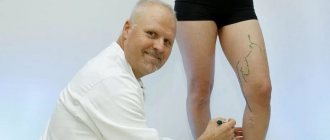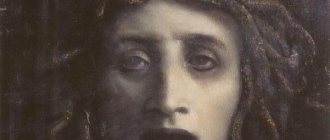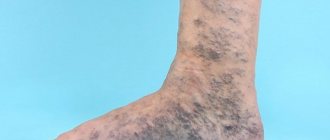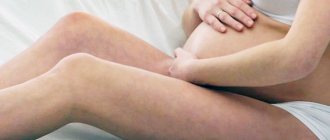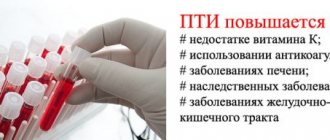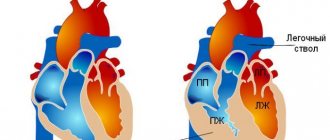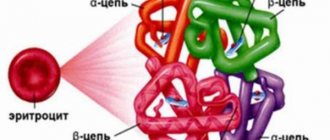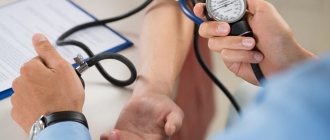Possible reasons
Treatment of any pathology depends on the cause that provoked it.
Therapeutic measures for pronounced veins can be medicinal and surgical. The last option is resorted to in two cases: either if the disease progresses and there is a risk of a large blood clot, or if the patient simply wants to eliminate an aesthetic defect.
| Cause of Vein Swelling | Therapy |
| Thrombophlebitis | Antiplatelet agents and anticoagulants, anti-inflammatory drugs, warm compresses. |
| Hereditary predisposition | An aesthetic problem that is inherited can only be eliminated through surgery. |
| Increased physical activity | Moderate exercise or temporary refusal of it will make the veins less noticeable. |
| Varicose veins | Surgical intervention or conservative treatment. |
General recommendations
To enhance the effect of drug or surgical therapy, you need to help the body remove (hide) visible veins.
For this:
- Drink enough clean, non-carbonated water. This will improve the structure of the skin of your hands, it will become smoother and more elastic.
- Avoid coffee and alcohol. This will make the skin color uniform, without a “gray” tint.
- Use hand creams. This can be either a simple moisturizer or a special anti-varicose cream. The latter will improve the tone of blood vessels, and, if the problem has not gone far, will hide them.
Hand exercises
There is a whole list of exercises (pictured below) that will help eliminate large veins.
Here are the most effective:
- Clasp your hands into fists, lower and raise them “all the way”, bending your hands – 10 times.
- Alternately extend your fingers to the back, then together.
- Gather the fingers of the right and left hands into a bun, lower them together downwards, bending the hand, return to the starting position - 10 times.
- Work your thumbs: pull them back and forth and to the sides.
- Clenching your hands into fists, twist them, bending your wrist.
- Forcefully bend and straighten your fingers into fists – 10 times.
- Place your palms together in front of your chest, bend your arms at the elbow joints, raise your elbows up, lowering your hands to your navel.
- Walk along any surface with your fingers, imitating playing the piano.
- Straighten your arms, point them in different directions, swing them in a circle - forward and backward.
- In the same position, bend your elbows and make circular movements of your limbs, first to the right, then to the left.
Such exercises, performed daily, can really improve the aesthetic appearance of the hands by restoring the tone of the blood vessels.
Conservative treatment is aimed not only at eliminating the visible defect, but also at stopping the cause that caused it.
| A drug | Group | Action |
| Venobene, Troxevasin, Dolgit | Local application | Relieves pain |
| Dipyridamole, Clopidogrel, Aspirin, Cardiomagnyl | Antiplatelet agents | Reduce the risk of blood clots, improve blood flow |
| Urokinase, Fibrinolysin, Trypsin | Fibrinolytics | Thinning blood, preventing blood clots |
| Trental, Pentoxifylline | Improved blood circulation | Prevents blood stagnation in the extremities, vasoconstriction |
| Ibuprofen, Ketonal, Dicloberl, Meloxicam | NSAIDs (non-steroidal anti-inflammatory drugs) | Relieves inflammation and pain |
Remember that you should never prescribe medications and treatment for yourself! This label is provided for informational purposes only.
Among the physiotherapeutic procedures that can help are taking a contrast shower twice a day for at least 10 minutes, and massage. It can even be done independently, at home, either with your hands or with the help of various massage devices. For dry skin, you should use cosmetic oil.
Hand baths (used in nail salons) are also used. Modern models are equipped with an infrared emitter; it is possible to conduct a session of magnetic therapy and vibration massage. Such comprehensive care will definitely improve the appearance of the hand area, relieve fatigue and relax them.
If, as a result of the course of the disease, the veins are very prominent, and drug treatment has no effect, then the patient will definitely undergo surgery. If there are no pathologies, but bloating is observed for some non-serious reasons, for example, as a result of heredity, then everything depends only on the desire of the patient himself.
There are several surgical options:
- Phlebectomy. This is the complete removal of a vein affected by varicose veins using special instruments.
- Sclerotherapy. This type of surgical intervention involves turning off the vein from the bloodstream (its functions are assigned to other vessels) and filling it with a special sclerotic fluid.
- Laser therapy. Veins that are swollen disappear under the influence of a laser, which glues them together from the inside. This is the most painless and gentle operation.
- Ultrasound thrombolysis. It is used if a blood clot has formed in the bloodstream. Then, with the help of a certain wavelength, it is destroyed.
Depending on the chosen surgical procedure, the rehabilitation period will vary. The shortest is with laser therapy, the longest is with phlebectomy. In the latter case, hands should not be subjected to heavy physical effort for a month.
The structure of the veins on the hands.
Age
Over the years, the skin loses its former elasticity. It is difficult not to notice that in older people the veins in the arms protrude more prominently. The reason for this physiological phenomenon is the absence of sebaceous glands and the thinning of tissues that occurs in humans with age.
The fatty layer of the skin hides the veins, but over the course of a person’s life it decreases, causing the veins to protrude outward. This type of varicose veins is not dangerous, as it reflects the natural aging process of the body.
Heredity
Bloating veins are almost always inherited. If the mother’s veins began to “rise” early, then the daughter, most likely, due to her genetic disposition, will also soon encounter an unpleasant defect. This feature is especially pronounced in people of thin build.
Weather.
Even weather conditions can have an impact on a person's veins. In summer, blood circulation is much faster than in winter, so you may notice small protrusions of veins due to vasodilation in hot weather.
The above reasons for varicose veins are not accompanied by pain. They do not pose a danger to the body, which cannot be said about varicose veins, which occur due to impaired blood circulation in the vessels. A blockage in any part of the veins is possible, which leads to the accumulation of venous blood, and as a result, to their swelling.
Most often, this pathology affects the lower extremities (legs), but varicose veins on the arms are also quite common. If there are a combination of signs of swelling and pain, you should immediately consult a doctor.
Physical exercise
Lifting weights, constantly carrying heavy bags, intense work in the garden - this and similar long-term physical activity affects the subcutaneous fat layer, and, accordingly, can contribute to bloating of the veins in the arms.
Thus, the most common causes of swollen veins do not cause the development of their disease. Therefore, in order to get rid of this kind of manifestation, it is not necessary to resort to radical measures. Surgery is only relevant as a last resort, when the unpleasant appearance of the hands is accompanied by severe pain. That is, only if the cause is varicose veins, the doctor can prescribe removal of the bulge.
Vascular disease of the upper extremities is less common than similar pathology in the lower extremities. With the same external pathological signs on the arms and legs, the causes of varicose veins are different.
Varicose veins are understood as irreversible swelling of venous vessels with the formation of nodal connections. Due to the expansion of the bloodstream, blood flow slows down and blood clots form. In these places, the walls become thinner, the vein twists, and a knot forms.
Varicose veins on the arms occur in people who are predisposed to this disease or who are engaged in heavy physical labor or who engage in weightlifting.
Factors contributing to the occurrence of pathology:
- high long-term load on the arm muscles;
- weak venousness;
- influence of medications;
- congenital angiodysplasia.
Lifting and carrying heavy objects is accompanied by increased blood flow. The arteries of the arms lie deeper in the muscle tissue than the veins, so venous vessels of increased diameter are visible.
A short-term expansion of the bloodstream is observed in all cases of excessive muscle load. With the cessation of traction forces, the walls contract to their normal state. Constant tension in the arm muscles causes irreversible dilation of the veins.
Weak venousness is a genetic predisposition in which the venous valves cannot withstand the pressure, and reflux (reverse blood flow) occurs. For this reason, not all people have the same results from the same physical activity.
When taking oral contraceptives, a blood clot may form, increasing blood pressure in the circulatory system. This primarily applies to women who are predisposed to thrombosis.
Parks-Weber-Rubashov syndrome is the presence of congenital macro- and microfistulas between arteries and veins. Increased functional load thickens the walls of venous blood vessels. In this case, varicose veins develop in any case.
The first sign of the disease is a visible venous pattern. It can appear on the outside of the hand, on the forearm, or on the entire arm.
The development of the pathological process is accompanied by blood stagnation, resulting in the formation of nodules in the veins of the arms. The expansion of veins and the formation of compactions begins from the hands and gradually rises upward. Vascular disorders can affect the lower phalanges of the fingers.
Further symptoms:
- bluish coloration of the venous pattern;
- blue discoloration of nearby skin;
- swelling of the fingers, hands, arms;
- painful sensations.
With congenital angiodysplasia, the first sign is hyperthermia of the skin at the location of the fistula. The elevated position of the hand does not reduce the pressure in the vessels; they cannot be compressed and pulsate at the site of the arterial-venous anastomosis.
Veins disappear in the arms: causes of deviation, treatment
/ Cuperosis
Back
: 22.02.2020
0
2
- 1 The leg turns black with varicose veins
- 2 Causes and clinical manifestations of pathology
- 3 The role of venous valves in the dilation and darkening of veins
- 4 Causes and clinical manifestations of pathology
- 5 Methods for detecting the disease 5.1 In children
- 5.2 In adults
- 6 How to remove stains
- 6.2 Blue tint
- 7 Symptoms of varicose veins
- 8 But there are cases when you should consult a doctor
- 9 How to speed up the process
- 10 Treatment of blue veins
- excess weight;
- sedentary lifestyle;
- work associated with carrying heavy objects;
- walking in uncomfortable high-heeled shoes;
- genetic predisposition;
- work in production that requires a long stay in one position.
The leg turns black with varicose veins
A detailed description for our readers: the leg turns black with varicose veins on the website varicose veins-cure.rf in detail and with photographs.
Darkening of the skin tissues of the lower extremities is a separate problem caused by the influence of various factors.
The main answer to the question of why the legs below the knees turn black is the disruption of blood flow in the veins. This problem is often encountered by people suffering from varicose veins or chronic venous insufficiency.
In some cases, a change in the color of the legs becomes a consequence of a disruption in the process of arterial blood flow. You should not try to whiten your skin on your own, because deterioration of the skin condition may indicate serious health problems.
If the skin on your legs turns black, this may be due to damage to peripheral blood vessels. This deviation accompanies diabetes mellitus, which negatively affects blood flow. Disturbance in the process of blood supply to organs leads to an increase in the time required for healing of wounds and ulcers.
In turn, damage to peripheral vessels is associated with a disruption of the blood circulation passing away from the heart through blood vessels. If diabetes is accompanied by an infection, the difficulty of removing it from the body lies precisely in poor blood flow. Black legs in this case may signal the development of gangrene - tissue death due to impaired blood flow.
When your legs turn black below the knees, you should think about the possible development of varicose veins.
When entering the legs, the blood must overcome gravity and rise upward. To accomplish this mission, nature has provided venous valves that allow biological fluid to pass in only one direction. Each heartbeat propels blood upward through the vessels, but when short pauses occur between contractions of the organ, the venous valves do not allow reverse blood flow.
With pathological dilatation of the veins, sufficient closure of the valves does not occur, and a gap forms between the heart wall and the valve. This defect disrupts normal blood circulation and causes veins to dilate.
What factors trigger such an unfavorable process? Experts highlight several points:
The presence of one or more factors places a person at risk, and poor heredity only accelerates the development of pathology. If there are cases of varicose veins in the family, it is advisable to play it safe and get advice from a phlebologist (vein specialist) or surgeon.
If your toe turns black, this does not always indicate a disease.
In winter, discoloration of the skin of the extremities may indicate frostbite. First, the skin affected by the cold turns white and loses sensitivity. Attempts to heat the problem area lead to pain and discoloration of the tissue to a blue-purple surface.
With severe frostbite, swelling develops that spreads beyond the affected area. Blisters form on the skin and its color is distorted. The integument can acquire a dark red or bluish color, even black.
Gangrene as a result of hypothermia of the feet or a consequence of diabetes mellitus manifests itself by blackening of the thumb and a number of pathological signs:
- redness and swelling of the foot;
- pain in fingers;
- burning of soles;
- pain in the calves when walking;
- freezing of extremities in warm conditions.
To prevent the development of gangrene, experts recommend taking Aspirin for a month (half a tablet twice a day). For preventive purposes, loose shoes should be worn. At the end of the day, it is useful to rinse your feet with cold water and rub them until they are red with a terry towel.
In your daily diet, you should limit the consumption of animal fats. Enriched with cholesterol, they are deposited in blood vessels and impair blood circulation.
It is also not recommended to indulge in salty and spicy foods and abuse smoking and alcohol.
If you have a problem with darkening of your legs, you should consult a dermatologist or therapist. Patients suffering from diabetes mellitus should consult an endocrinologist. If you have signs of varicose veins, it is recommended to go to a vascular surgeon.
When the legs swell and turn black, such abnormalities can be considered as limb injuries. If soft tissues involved in the lymph or blood flow of the lower extremities are damaged, a person may experience chronic swelling in the affected leg. At the same time, the injuries themselves and the methods of their treatment increase the risks of developing venous insufficiency and deep vein thrombosis.
Swelling of the legs in their lower part can occur due to various reasons. The most harmless of them is fatigue, the most dangerous is heart failure. Signs of pathology are:
- symmetrical location of edema;
- growth of lesions in size;
- spreading to the thighs.
With diseases of the thyroid gland, problems with the legs are accompanied by disturbances in the functioning of the gastrointestinal tract, swelling of the tongue and drowsiness. Problems with the kidneys are indicated by swelling of both extremities (on the back of the foot), changes in the color of urine and the appearance of dark circles under the eyes.
What to do if your leg turns black? You can solve the problem yourself by increasing physical activity and visiting a bathhouse (at elevated temperatures, the blood vessels will return to normal).
Among the medications, drugs are indicated that strengthen the walls of blood vessels and prevent thrombosis.
What should I do if my legs begin to turn black below the knees? What could cause such a strange phenomenon? Not only does black legs cause a lot of trouble, especially for women, but the black color also creates fear of various diseases.
The reason for the blackening of the legs below the knees is the basis of impaired blood flow in the vascular bed. Arteries and veins function as channels through which blood flows, it nourishes tissues and organs, supplies them with oxygen and transports hormones, removes metabolic waste products, and also regulates body temperature.
A striking example of impaired blood flow in the lower extremities are diseases such as diabetes, varicose veins, gangrene, frostbite of the skin.
Whatever causes the darkening of the skin, you need to understand that neither powder nor foundation will help, but will only further develop symptoms of possibly very dangerous diseases.
The symptom of blackening of the legs can be treated only by influencing the original source. If dark spots are caused by diabetes, then the first thing you need to do is contact an endocrinologist and tell them in detail what is bothering you. The doctor will take the necessary measures and prescribe medications that normalize blood flow in the lower extremities.
If the toe turns black, then most likely the person is developing gangrene.
Treatment of gangrene is aimed at stabilizing blood flow, blocking the spread of infection, and restoring the functionality of the toes.
Antibiotics in the maximum dosage and ointments, for example, “Iruksol” Levomekol, physical therapy and taking complex vitamins, as well as strengthening the body’s immune forces will save you from gangrene; to prevent skin dying, it is useful to walk barefoot on the ground.
We suggest that you familiarize yourself with Treatment of thrombophlebitis of the lower extremities of the internal deep veins
Varicose veins and venous insufficiency are cured by surgery (in advanced cases) and taking medications, folk remedies, proper nutrition and prevention.
Aspirin-containing drugs.
Phlebotonics:
- Detralex
- Angistax
- Phlebodia
- Venoruton
- Troxevasin
- Aescusan
- Reparil-gel
Thus, blackening of the legs below the knees comes down to treating the original source of the disease, and not the symptom itself.
The role of venous valves in the dilation and darkening of veins
The normal operation of valves in the veins depends on the general condition of the blood vessels in the human body. Pathology occurs when there is a disruption in the functionality of blood vessels. These deviations affect their blockage. This is what provokes expansion.
The valves do not stop functioning immediately, but gradually. Because of this, vasodilation occurs. Excess blood accumulates in one place and provokes negative changes in the structure and functions of the vessel.
Vascular pathologies are observed throughout a person’s life. They can be triggered not only by lifestyle and diet, but also by uncomfortable clothing, diseases and bad habits. It is necessary not only to treat this disease, but also to carry out preventive measures from a young age.
Prevention
Experts say that often the reason why veins appear is the neglect of preventive measures after 30 years. To keep your hands in an attractive condition, you need to follow a few simple recommendations:
- stop smoking and reduce alcohol consumption to a minimum;
- include physical exercise of moderate intensity and load into your routine;
- Massage your arms and hands as often as possible;
- do not neglect hand baths with sea salt and soda;
- adjust your diet by including more healthy vegetables, fruits and grains;
- use nourishing hand cream, sometimes rub in vegetable oils;
- try as little as possible to wear clothes and jewelry that fit tightly to the hands, blocking the flow of blood to the limbs.
Why veins protrude on the arms often depends on a person’s lifestyle. To eliminate this disease, you need to start first of all by changing your habits, supplementing your daily routine with simple exercises. You should also set aside time for cosmetic procedures - perform contrast baths, massages and masks. Only in special cases resort to radical measures.
Causes and clinical manifestations of pathology
Experts say that people with light skin tones have much better visible veins than those with darker skin. And there is nothing scary or unusual about this. Just like in situations where a person has thin skin. It is not uncommon to see visible veins on the arms, legs, and other parts of the body in older adults.
The veins of the lower extremities are very vulnerable, since they bear the heaviest load. The most common disease that signals bulging and blue veins is varicose veins. Blue dilated veins with varicose veins are a sign of disruption of natural blood circulation.
Also, the cause of blue veins is poor valve function. Blood begins to accumulate in the veins, in which pressure increases, forming nodes. This process takes certain years before blue veins in varicose veins become a risk factor. Externally, blue veins with varicose veins appear as highly swollen, blued (less often reddened) sections of blood vessels.
In your daily diet, you should limit the consumption of animal fats. Enriched with cholesterol, they are deposited in blood vessels and impair blood circulation. It is also not recommended to indulge in salty and spicy foods and abuse smoking and alcohol.
We suggest you read: Is it possible to take a steam bath for gout?
What to do if your leg turns black? You can solve the problem yourself by increasing physical activity and visiting a bathhouse (at elevated temperatures, the blood vessels will return to normal). Among the medications, drugs are indicated that strengthen the walls of blood vessels and prevent thrombosis.
Varicose (venous) dermatitis is a complex of skin changes (from redness and itching to the appearance of ulcers on the skin) that occur against the background of advanced varicose veins of the lower extremities. It has no gender differences, so it can occur in both women and men.
The appearance of venous dermatitis indicates the progression of varicose veins of the lower extremities and requires immediate treatment.
A person has trained muscles
Adipose tissue is located in the subcutaneous layer, so in obese people it largely covers the veins, making the hand plump without bluish streaks. If a person is thin, then it will not be possible to avoid visible veins, which will also bulge when pressure changes or increases in air temperature.
Source: https://cosmeton.ru/krasota-i-zdorove-zdorove/povylazili-veny-na-rukah.html
Associated symptoms
In the case of pathological provoking factors, pronounced veins usually cause not only aesthetic, but also physical discomfort.
This mainly manifests itself:
- heaviness and pain in the hands;
- swelling of the hands.
One of the common symptoms is a constant desire to fix the arms above the level of the head (in this position, the outflow of stagnant blood improves).
In difficult cases, when vein pathology is caused by serious circulatory disorders, as well as thrombophlebitis, the following is observed:
- slight increase in body temperature;
- hyperemia of the skin of the hands;
- lump, lump, lump, swelling or ball at the site of the lesion;
- swelling, blueness;
- change in skin color;
- muscle weakness;
- the appearance of ulcers on the skin.
Drug therapy is one of the main treatment options
If veins appear in the legs, the doctor will definitely begin treatment with drug therapy. A phlebologist conducts a comprehensive examination of the vessels of the lower extremities to determine the location of the altered vein, diagnose its condition and prescribe the necessary medications. All therapy is necessarily comprehensive in order to relieve unpleasant symptoms and prevent complications.
Drug therapy uses:
- non-steroidal anti-inflammatory drugs;
- anticoagulants;
- venotonics.
Almost all drugs in these groups require a specific treatment regimen. The tablets are taken in courses over a long period of time.
Among the most effective medications, doctors identify the following:
- Detralex.
- Phlebodia.
- Wearus.
- Troxenvazin.
- Lyoton.
- Ascorutin.
- Aspirin.
- Chimes.
The action of these drugs is aimed at normalizing blood flow in the vessels of the lower extremities, and unpleasant symptoms disappear.
In cases where severe pain and inflammation appear in the patient’s legs, anti-inflammatory ointments and injections containing Diclofenac may be recommended.
Latest information: Fatigue and heaviness in the legs
Differential diagnosis
Causes
Varicose veins of the hands most often occur in women, especially after pregnancy. Also at risk are people who are overweight or spend a lot of time on their feet. Stagnation causes unpleasant consequences.
The main reasons for dilated veins in the arms include the following:
- Changes in the structure of blood vessels as a result of congenital deformations of the development of venous valves;
- Carrying heavy objects, high loads on the muscle tissue of the arms and shoulders, playing strength sports;
- Constant stressful situations;
- Thin build and thin skin;
- Drinking alcohol and smoking;
- Genetic predisposition.
In women, varicose veins in the arms are often a consequence of the use of hormonal contraceptives. Such drugs can lead to imbalance of hormones.
People who are at risk need to closely monitor their health. Thanks to the timely detection of pathology, it will be possible to begin treatment and prevent negative consequences. In advanced cases, it will not be possible to do without surgical intervention.
Clinical picture
Symptoms of varicose veins on the hands can be seen visually. The pathology is characterized by pain and numbness of the hands and forearms. Aching discomfort in the hands especially often occurs as a reaction to changing weather conditions. As the disease progresses, patients experience difficulty carrying heavy objects.
The main symptoms of varicose veins of the hands include the following:
- The veins swell, become larger, and a pronounced venous pattern is visible on the chest;
- When you raise your hands up, the size of the veins decreases;
- There is swelling of the hands, they become hot and heavy;
- When you clench your fist, the blueness in the area of the veins increases;
- With constant burning pain, night sleep is disturbed, a person becomes depressed, headaches and discomfort in the heart occur.
Diagnostics
To identify pathology, you should contact a phlebologist or vascular surgeon. It is believed that dilated veins in the arms do not pose a health hazard. However, in difficult cases, doctors do not limit themselves to a visual examination, but refer patients to Doppler ultrasound and angiogram.
Doppler ultrasound allows you to evaluate blood flow in the veins and look for possible blood clots. In this case, special sound waves are used. This allows you to obtain information about blood circulation in the vessels.
To study the blood flow in the veins in more detail, an angiogram is used. To carry out the procedure, a dye is injected into the vessels. This makes them stand out on the x-ray.
Treatment methods
At the initial stage, the pathology can be easily treated. Treatment of varicose veins on the hands can be carried out using medications and folk remedies. Specific methods of therapy are selected individually.
It all depends on the severity of the manifestations and the results of diagnostic studies.
The main direction of diagnosis is the study of blood vessels, excluding severe diseases. For this, the patient is referred for venography or ultrasound.
To complete the diagnostic picture, the patient will need to undergo blood and urine tests. Only based on the results of the research will the doctor be able to prescribe adequate treatment.
If the examinations did not reveal any pathologies, then the specialist may recommend simply changing your lifestyle.
Recognizing varicose veins is usually not difficult. A specialist can accurately determine the presence of pathology even simply by the appearance of the patient’s hands. A positive diagnosis will be made if the following signs of the disease are present:
- The vessels in the hands increase in size and protrude greatly;
- Swelling of the upper extremities is observed;
- It becomes difficult for the patient to move his fingers intensively and quickly;
- The patient complains of a feeling of heaviness and pain in the area of swelling;
- Fingers often go numb;
- During sleep, the patient experiences increased discomfort, which is caused by disruptions in blood flow and blockage of blood vessels in the upper extremities. This gives rise to the desire to “raise your hands up,” as it were.
When vasodilation occurs against the background of certain chronic diseases (dental problems, diseases of the reproductive system, etc.), additional symptoms are observed, which include:
- Skin thickening;
- Severe pain;
- Swollen hand skin;
- Temperature increase.
Along with the above, a form of inflammation such as the formation of a blood clot under a vein is also possible. This disease is dangerous for people suffering from cardiovascular diseases (those who have previously had them are no exception). Pregnant women are also at risk - the pathology can lead to complications during childbirth.
Another disease associated with varicose veins is migratory thrombophlebitis, in which, in addition to swelling of the veins, spots appear, mostly brown. It occurs mainly in men.
This pathology consists in the fact that blood does not flow to the necessary tissues, and the structure of the blood circulation as a whole is disrupted. The following signs are typical for diagnosing this disease:
- When you raise your arms, the condition of the veins on them does not improve (the vessels still remain compacted);
- The arm susceptible to pathology is slightly longer than the other;
- Possible formation of ulcers on the skin of the affected limbs;
- In areas where the disease is localized, tissue vibration is observed.
We should also not forget that only a phlebologist can conduct the most complete and detailed examination of the patient. Then, if he has such signs, make a final diagnosis and prescribe therapy.
1. Drug treatment. With the help of various drugs, you can improve the condition of the veins, give them elasticity and get rid of the unaesthetic disease. The following medications are considered effective:
- Aescusan, Varicobooster - creams and ointments for external use (rubbing the affected areas of the hands with varicose veins);
- Phlebodia is a drug for oral administration;
- Along with medicines, traditional medicine is also widely used. This includes preparations containing mumiyo, as well as those made from lily of the valley, chestnut and other medicinal plants.
However, you should choose medications based on the doctor’s prescription, and not treat yourself: varicose veins are characterized by individual manifestations, so medications and dosage are selected specifically for each patient.
2. Surgical intervention. Protruding veins can sometimes become a big problem. This happens, for example, in cases where the vessels are so visible that standard treatment methods do not help to at least reduce such manifestations to a minimum.
The result of sclerotherapy treatment.
Scleropathy. This method is chosen quite rarely. This is due to the fact that sclerotherapy requires compliance with many nuances and very delicate and painstaking work on the patient’s hands. And if an inexperienced specialist undertakes treatment, the pathology will not only not go away, but will also lead to the spread of severe pain throughout the entire limb.
The mechanism of sclerotherapy consists of removing the vein from the circulatory system and subsequent gluing of the vessels using a special foam or liquid. This type of intervention is more in demand if the veins are swollen not only in the arms, but also in other parts of the body.
Phlebectomy. A surgical procedure such as phlebectomy helps to completely remove the bulging vein in the arm using special instruments. However, you need to remember that after the operation you can no longer use the veins in your arms to give injections.
Laser therapy. Along with surgery, there is a less invasive method of treating varicose veins - laser. It is also used for more serious forms of venous disorders. The essence of this therapy differs from surgical intervention in that the walls of the vessels are glued together due to the action of the laser. Thus, proper blood flow is restored, and as a result, the swelling in the arm goes away.
Hirudotherapy. This is a method of treatment using leeches. They produce a special enzyme that has a positive effect on the circulatory system and increases the elasticity of tissue in the affected area. Despite its somewhat unconventional nature, this method helps even with severe swelling of the veins in the arms.
As we can see, there are many ways to treat swollen veins in the arms. However, to choose a specific method, including surgery, it is necessary to find out the original causes of the pathology, which are often physiological changes.
Therefore, it is not always necessary to resort to surgical intervention. Moreover, the operation can only be prescribed by a medical specialist.
New life is the key to excellent prevention
Any disease is easier to treat if it is started at an early stage. At the first clinical manifestations, you need to consult a doctor, undergo diagnostic tests and a course of treatment. Before the veins in the legs pop out, patients may experience symptoms of the disease.
Among the most striking are the following:
- feeling of discomfort;
- burning;
- fatigue;
- heaviness;
- pain;
- night cramps.
Doctors have compiled a list of recommendations, following which you can not only get rid of the disease at the initial stage of its development, but also take preventive measures to prevent varicose veins:
Balanced, nutritious meals at scheduled times. In many cases, the viscosity of the blood and loss of elasticity of the walls of blood vessels are caused by the wrong food: fatty, salty or smoked. Doctors recommend eating lean fish, meat, and fresh herbs. Increase the amount of raw or steamed vegetables
The following products stimulate the work of the veins of the lower extremities well: blueberries, lemon, sea buckthorn, figs. It is extremely important to exclude sweet and starchy foods from your diet. Dried fruits can be consumed in limited quantities to be tasty. If a vein pops out in your leg or symptoms of fatigue appear, you need to stop wearing heels.
Latest information: Varicocele and testosterone
For many women, wearing tight shoes that compress the foot causes the disease. Shoes should be comfortable, the heel should not exceed 5-6 centimeters. Problems with blood vessels may occur due to wearing tight pants. They compress the pelvic organs, disrupting blood flow in the lower extremities. For people who are susceptible to the disease or have a genetic predisposition, wearing jeans or dresses that tightly compress the waist is contraindicated. When sitting in a chair or on a chair, you must avoid a pose where one leg is placed on top of the other. In this case, a vein in one of the limbs is compressed, which also has a detrimental effect on the blood vessels. People who have at least once encountered clinical manifestations of varicose veins are contraindicated from steaming in saunas or taking hot baths. Ideal weight. For your height and age, you need to calculate the ideal weight to reduce the load on your lower limbs.
When starting the fight against the first symptoms of the disease, do not forget about a healthy lifestyle and activity. Doctors recommend moving more, walking or cycling, and visiting the pool. This cardio exercise improves heart function and strengthens the walls of blood vessels throughout the body.
When resting in the evening, at night, you should always put your feet on a small hill. This will drain the blood and give your legs proper rest.
By following these simple recommendations, many manage to get rid of the disease at its first signs or protect their blood vessels if they have a genetic predisposition.
https://youtube.com/watch?v=VuMiHOPa9Xw
Prevention
Preventive measures aimed at preventing the swelling of veins on the surface of the skin of the hands come down to reasonable exercise and a healthy lifestyle.
They include:
- charging;
- quitting smoking, alcohol and coffee;
- taking a contrast shower;
- balanced diet.
Author of the article:
Dmitrieva Yulia (Sych)
– In 2014, she graduated with honors from Saratov State Medical University named after V.I. Razumovsky. Currently working as a cardiologist at the 8th City Clinical Hospital in the 1st clinic.
The best way to deal with protruding veins is to prevent them from appearing. This is very simple to do: from the age of 30, it is enough to actively care for the skin of your hands, moisturize it and follow several preventive recommendations.
An important role is played by exercises that should be performed in combination:
- Simple stretching of the fingers, bending the palm into a fist and extension;
- Arm movements like “swinging” (raising your arms up and down to improve blood circulation);
- Spreading fingers;
- “Walking” with fingers on a hard surface.
When performing exercises, try to stretch your fingers and arms as much as possible, but at the same time avoid discomfort. Also, for the prevention of varicose veins, massage of the fingers and hands is useful, which should be given at least a small amount of time every day.
In addition to exercise and massage, nutrition and a healthy lifestyle play a role in the bath. If you want to keep your hands in beautiful condition for many years, wake up with a smile, do exercises in the morning, take a contrast shower. Diversify your diet with plenty of vegetables and fruits.
Thus, the appearance of excessively protruding veins can be easily prevented using simple rules. However, if the disease still persists, consult a doctor who will give recommendations for treatment. If the disease does not cause pain and severe discomfort, as well as other additional symptoms, then there is no cause for concern and bloating will not harm your health.
Veins in my arms are missing, how to restore them
The situation when a person has bad veins in the arms may be associated with thin walls of blood vessels and capillaries, poor blood circulation or other physiological factors.
This is generally a harmless phenomenon and causes discomfort only during medical procedures (injections, blood draws). Often, insufficient qualifications of the nurse complicate the procedure when they are hiding and need to be looked for.
To establish the exact cause and diagnosis, you should consult a doctor who, if necessary, will recommend appropriate treatment.
IT IS IMPORTANT TO KNOW! Even “advanced” varicose veins can be cured at home, without surgery or hospitals. Just read what Ekaterina Andreeva says and read the recommendation.
How veins are restored after IVs: useful procedures
In the section Doctors, Clinics, Insurance to the question Good day everyone. Can the veins in the arms completely disappear, so that an experienced physician cannot administer an intravenous one? My offer to visit Petushki remains valid.
I promise to hit any vein, which I have been doing non-stop for 30 years. It is stupid to insert a subclavian catheter for the sake of one injection. Well, it happens with veins. MS intensive care. The veins have not gone away, you just need to find them.
It’s the inexperienced nurses who end up, such a nurse will even pierce and mutilate an excellent vein.
Alternative Therapies
If the veins become very enlarged and protrude, but there are no blood clots or a threat to health, alternative medicine can come to the rescue. This is a whole set of folk recipes, treatment with leeches, acupuncture.
Important: before deciding on unconventional methods of treatment, you need to consult a doctor and make sure that the chosen method will not harm or aggravate the situation. Poor patient tests will be the first contraindication for the use of alternative medicine methods.
Reviews from doctors about alternative medicine are mixed, but all experts agree that they can only be used when there are no blood clots or visible varicose veins.
Folk recipes
We bring to your attention popular recipes for folk remedies that can help with swollen veins in the hands:
- Take a green tomato (according to the degree of ripeness), cut it into slices, place it on your hand in the place where the veins emerge and swell, and wrap it with an elastic bandage overnight. In the morning, remove everything and spread the skin with a high-fat cream.
- Mix crushed wormwood (3 tablespoons) with the same amount of curdled milk, smear the resulting medicine on your hand and wrap it in cling film. After 20 minutes, remove the compress and spread the skin with rich cream or sour cream. This will take up to a month.
- Apple cider vinegar and birch bud tincture are mixed 1:1, rub your hands with the resulting mixture twice a day.
- Chopped garlic and butter in equal proportions are mixed and applied to the hands in places where the veins are swollen. The compress needs to be insulated as much as possible (using cling film and a towel on top). You will have to smear visible veins for up to 5 months.
- Drink herbal tea: rose hips, blueberry leaves, rowan berries and St. John's wort are mixed in equal parts. Take half a glass twice a day, brewing a tablespoon of the resulting tea with boiling water.
Hirudotherapy
Treatment with leeches is practiced even with pronounced veins, when the hands swell from insufficient blood outflow.
The essence of hirudotherapy is that a specially grown medical leech is placed on a patient at a certain point on the body. During the bite, a substance, hirudin, enters the blood, which thins it and prevents blood clots.
Patients note an improvement in the appearance of their hands and overall well-being after the first session. After manipulation, the leech is placed in medical alcohol.
Acupuncture
Using this method, certain points of the human body are affected by introducing special thin needles into them. They activate biological processes in the body, thereby restoring normal blood flow and preventing congestion.
This method is not recommended for everyone, as it has a number of contraindications. Before deciding to go to an acupuncture session, you need to take all the tests and notify your doctor.
Other reasons why such a defect may occur
There are several other reasons why the veins in the arms swell, namely:
- Swelling may appear on the surface of the hands due to severe weight loss. In this case, the patient will observe the appearance of bluish or purple vessels on the extremities. It is worth noting that this defect, in addition to its unsightly visual appearance, no longer causes any concern;
- Excessively thin people may exhibit a peculiar vascular pattern. The thing is that in this condition, the skin of the hands has a dry and thin structure, due to which protruding veins can be overlooked. In such a situation, the vascular system is completely healthy, the only problem is that it is unaesthetic, which often confuses women;
- If the veins on the arm under the skin are swollen in elderly people, then this is the first sign of age-related changes. In this situation, such a phenomenon is considered normal and does not require any intervention;
- Quite often, veins can become swollen due to hormonal changes. As a rule, women are more susceptible to such failures, and this failure occurs during pregnancy, puberty, or at the beginning of menopause.
All of the above reasons do not require medical therapy. But in any case, a person should seek advice from a specialist to find out the true cause of this defect.
Do not forget that varicose veins are a very dangerous disease and only a doctor can diagnose it.
What are the characteristics of varicose veins on the hands?
Cases of varicose veins appearing on the hands are not isolated. Women suffer from it more often. The disease causes discomfort and psychological dissatisfaction with the appearance of hands. In addition, there is pain in the limbs, which intensifies over time.
This is a serious pathology that affects the functioning of the heart and the entire circulatory system. It implies swelling of the veins located directly under the skin (varicose veins on the arms are striking even in the photo).
This is due to blood stagnation, which appears due to disturbances in its inflow and outflow. As the fluid accumulates, it stretches the veins. The vessels are elastic, so they easily increase in size and fit tightly to the skin.
In this case, nodules form and the veins turn blue.
The danger of the disease is that due to the disruption of blood flow to the valves, the heart receives a large load that is difficult for it to cope with. Symptoms appear quickly enough, so signs of pathology can be immediately noticed. It is advisable to start treatment as early as possible, without waiting for complications to appear.
Reasons for appearance
Women are believed to be susceptible to this disease.
- burdened heredity. In a significant proportion of patients suffering from this pathology, parents and other relatives also had problems with varicose veins;
- congenital problems with heart valves;
- physical overload. High activity leads to an increase in blood flow, which causes further stagnation;
- chronic stress;
- taking oral contraceptives without consulting a doctor. Due to long-term contraception in this way, a woman’s hormonal levels are disrupted, so such drugs should be prescribed by a specialist;
- regular consumption of alcohol and nicotine. Due to frequent consumption of alcoholic beverages, edema appears, which contributes to the appearance of venous congestion;
- natural disturbances in the endocrine system.
Women are believed to be susceptible to this disease. In men, the pathology occurs two times less often. This is explained by the weak shoulder girdle in women, so the outflow of blood is difficult. In addition, men have more stable hormonal levels.
To successfully treat varicose veins on the hands, you need to notice the symptoms of the disease in time.
Symptoms
To successfully treat varicose veins on the hands, you need to notice the symptoms of the disease in time. They differ in clinical picture depending on the severity of the disease. It is advisable to immediately recognize the symptoms of varicose veins on the hands in order to quickly differentiate the disease and begin treatment.
The first signs of pathology:
- swelling of the veins to such an extent that they appear through the skin;
- changing their shape;
- veins can be felt;
- the appearance of blue nodules.
Such symptoms should prompt you to urgently consult a doctor. A phlebologist treats varicose veins. If you ignore the first signs of pathology, the disease will progress, which will lead to a significant deterioration in the patient’s life.
A phlebologist treats varicose veins.
Clear signs of progression of varicose veins:
- unpleasant sensations appear in the hands, pain occurs;
- at rest, numbness of the upper extremities is felt;
- veins swell even with a passive position of the hands;
- there is swelling and peeling of the upper extremities;
- rapid hand fatigue is noticeable.
There is also a dependence of symptoms on meteorological factors. Sudden weather changes exacerbate discomfort.
All these signs are visible, so timely contact with doctors is required, otherwise venous congestion will lead to disturbances in the activity of the heart and the functioning of the upper extremities.
However, these manifestations do not always indicate varicose veins. A similar phenomenon applies to people with low body weight, low collagen content and thin skin. In this case, protruding veins are not a pathology.
A similar phenomenon applies to people with insufficient body weight
If you ignore the symptoms of the disease and do not treat it, there is a risk of various complications. This occurs due to chronic stagnation, as a result of which toxins accumulate in the body and tissues do not receive enough oxygen.
The most common and unpleasant complications of varicose veins on the hands of women:
- violation of the integrity of varicose nodes. Nodes can be damaged even under light loads. As a result, heavy bleeding begins, which cannot be stopped on its own and requires medical help;
- trophic ulcers as a consequence of oxygen starvation and regular release of toxins into the body. Secondary infection is possible. These ulcers bring a lot of discomfort;
- thrombophlebitis. Constant blood stagnation leads to the formation of blood clots. They clog the lumens of blood vessels. This complication sometimes leads to death, so it is impossible to do without medical help.
In cases where the previously mentioned complications cannot be avoided, it is worth undergoing treatment so as not to aggravate their further development. To do this, you need to contact a specialized doctor - a phlebologist or a vascular surgeon. After all the necessary studies have been carried out, therapy is prescribed.
Constant blood stagnation leads to the formation of blood clots
Veins disappear in the arms
The situation when a person has bad veins in the arms may be associated with thin walls of blood vessels and capillaries, poor blood circulation or other physiological factors.
This is generally a harmless phenomenon and causes discomfort only during medical procedures (injections, blood draws). Often, insufficient qualifications of the nurse complicate the procedure when they are hiding and need to be looked for.
To establish the exact cause and diagnosis, you should consult a doctor who, if necessary, will recommend appropriate treatment.
IT IS IMPORTANT TO KNOW! Even “advanced” varicose veins can be cured at home, without surgery or hospitals. Just read what Ekaterina Andreeva says and read the recommendation.
Veins protruding on the legs: symptoms and treatment
Ignoring the external symptoms of bulging veins can lead to very adverse consequences. Therefore, if the veins in your legs begin to protrude, you should immediately consult a doctor to undergo an examination and determine the cause. If the veins in the legs protrude due to physiological characteristics or as a response to a temporary irritant, then the doctor will certainly tell you about it. He will recommend how to avoid the irritant and tell you how to eliminate the symptoms that have arisen. If the specialist determines that the protruding veins on the patient’s legs are a consequence of developing varicose veins, he will prescribe an appropriate treatment regimen.
What treatment methods do specialists use when the veins in the legs protrude due to varicose veins? Is it possible to carry out treatment with folk remedies? Are there any safe treatments during pregnancy? Read the answers to these and other questions further in our article.
Treatment of varicose veins is possible using various methods. The choice of the most suitable methods for the patient is always made by the doctor based on the examination results.
!
According to VTsIOM, a third of the Russian population does not go to doctors.
Self-diagnosis and self-medication will not only take up time and money, but may well contribute to the development of the disease, which will become more complicated. Only a doctor can objectively assess the situation and take into account the beneficial and side effects of the chosen treatment method.
When laboratory tests and an ultrasound report indicate that all indicators are normal, and the studied vascular parameters and the type of blood flow correspond to acceptable values, no additional diagnostics are required. Not only MRI and duplex scanning of blood vessels, but also other diagnostic methods are prescribed if necessary to clarify the preliminary diagnosis. If a vascular ultrasound showed that at the moment there is no significant reason for concern, this means that varicose veins were detected at the initial stage.
Veins on the legs protrude, reasons
In addition to protruding vessels, the clinical picture of varicose veins at the first stage may include the following manifestations:
- a feeling of heaviness in the legs, as a sign of rapid fatigue;
- vascular pattern in the form of meshes, stars;
- pain in the calves, associated with a feeling of fullness;
- slight swelling in the ankle area at the end of the day, which goes away after rest;
- cyanosis of the skin and the appearance of age spots.
In this case, the doctor will use conservative treatment methods. The first thing he will recommend is to make adjustments to your lifestyle:
- have a correct daily routine with an appropriate distribution of time for sleep, rest and work;
- monitor your own emotional background - live in harmony with yourself and be less nervous;
- lead an active lifestyle, play sports, walk in the fresh air, etc.;
- eat a balanced diet;
- try to avoid hot rooms, visiting baths and saunas.
Expert opinion
To reduce the symptoms of varicose veins and prevent the disease from progressing, your doctor may prescribe wearing compression stockings. It normalizes the functioning of the circulatory system in the lower extremities. Compression garments provide precise calculated pressure for prevention and treatment. Prophylactic knitwear has the lowest degree of compression and can be purchased independently. Therapeutic knitwear has several degrees of compression and is selected based on the individual parameters of the limb. The choice of products will be made by a specialist based on the location of venous disorders and the severity of the patient’s condition.
Vascular surgeon, phlebologist
Osipova Ekaterina Yakovlevna
Anti-varicose jersey for diseases of the veins on the legs
As a rule, along with wearing compression hosiery, the use of external medications is prescribed for the prevention and treatment of varicose veins. In the initial stages of the disease, it is effective to use products for the lower extremities from the NORMAVEN® line of medical cosmetics: cream and spray tonic. Both products are made from natural ingredients. "NORMAVEN®" foot cream is applied to the skin 1-2 times a day with massaging movements. The cream is absolutely safe when used during pregnancy, which is confirmed by clinical trials. In addition, it will not damage the fibers of compression garments, so application of the product is possible not only after removing the jersey, but also before putting it on. "NORMAVEN®" foot tonic spray is ideal for long trips and for use at work under prolonged static loads. It has an immediate venotonic effect, restoring lightness and comfort to the legs. Spray 1-2 times a day from a distance of about 15 cm until the skin feels moisturized.
At home, you can do self-massage of your feet, take a contrast shower, make warm foot baths with sea salt, essential oils and herbal decoctions. When veins protrude on the legs, infusions of medicinal plants (in accordance with folk recipes) can be taken both internally and as rubs. But such treatment can be carried out only after consultation with a doctor. It is important to understand that alternative medicine should not replace the main therapeutic regimen.
Expert opinion
The doctor may also prescribe a number of gymnastic exercises, which, when performed on a regular basis, can significantly improve the patient’s condition. It is enough to perform a similar set of exercises every day for 10-15 minutes to tone the blood vessels.
Vascular surgeon, phlebologist
Osipova Ekaterina Yakovlevna
If the symptoms are pronounced, the doctor may prescribe medications to be taken orally. They are usually taken in courses during periods of exacerbation. The most popular are drugs based on heparin, troxerutin and diosmin.
Not all of the above methods will be effective for treating varicose veins. Despite the comprehensive approach to treating the disease and the use of conservative drug therapy methods, doctors often have to turn to radical methods, such as minimally invasive procedures and surgeries.
Treatment of affected blood vessels in the legs
Minimally invasive methods for removing diseased veins include:
Sclerotherapy
During this painless procedure, the doctor injects a sclerosing drug or a cocktail of drugs into the vein that removes blood from the affected vein. The vessel “sticks together” and is excluded from the bloodstream;
Laser coagulation
The vein is “sealed” with laser energy through a light guide inserted into it. To perform this procedure, not only a laser unit is required, but also an ultrasound machine;
Causes and Effects
In general, experts associate chronic venous insufficiency in both women and men primarily with heredity. In particular, if both parents have varicose veins in their legs, the risk of developing them in their offspring is 89%. If only one of the parents suffered from this, the risk is reduced to 47%.
A number of other factors also contribute to the development of the disease. First of all, these are the characteristics of the profession and lifestyle.
If your job requires you to stand or sit for a long time, you are at risk. Judge for yourself - in 30 minutes of such a static state, the blood volume in the lower extremities increases by 250-300 milliliters, and the veins of our poor legs must stoically withstand this load.
But there are millions of people in such professions. Here is another explanation for the high prevalence of vein problems.
Other risk factors:
- Frequent air travel or car travel.
- Low physical activity.
- Poor nutrition.
- Obesity.
- Heavy physical activity.
- Staying in a hot climate.
- Some types of hormonal contraception.
It is also worth mentioning the notorious environment, and our chronic diseases, and stress. Varicose veins often appear in old age, when adequate nutrition of the cells and tissues of the body is disrupted.
